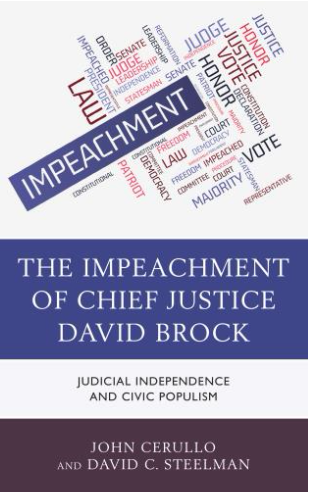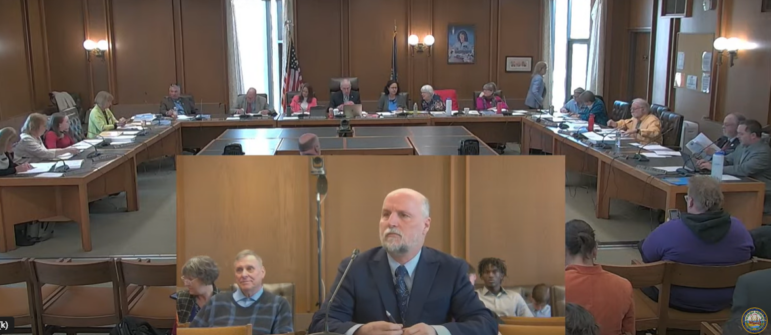The following article is based on the authors’ book, entitled, “The Impeachment of Chief Justice David Brock: Judicial Independence and Civic Populism” (Lexington Books, 2017). The article outlines the book’s treatment of factors that led to the impeachment trial of Chief Justice Brock in 2000; the impeachment proceedings themselves; and the changes in legislative-judicial relations that followed it. The authors view the impeachment crisis as both a pivotal event in the state’s modern history, and as a valuable lens on the purpose and nature of impeachment itself in the American system of governance.

John Cerullo
John Cerullo received his BA in History (Honors) and PhD in History from the University of Pennsylvania. He is Professor Emeritus (History) at the University of New Hampshire at Manchester, where his courses’ subject matter included the “rights revolution” of recent times and the historical evolution of the idea of the “rights-bearing” citizen. A former visiting scholar at Boston College Law School, his publications include work on “wrongful life” litigation and a book on French military justice, entitled, Minotaur: French Military Justice and the Aernoult Rousset Affair (2011).

David Steelman
David C. Steelman graduated Phi Beta Kappa from the University of New Hampshire with a BA and MA in History. After graduating from the Boston University School of Law, he joined the National Center for State Courts, working as a staff attorney, then a regional vice president, and finally a principal court management consultant, until his retirement at the end of 2013. In 2004, he was a visiting scholar at the University of Bologna’s Research Institute on Judicial Systems. His recent books include Caseflow Management: The Heart of Court Management in the New Millennium (lead author) (2000, 2004) and Model Time Standards for State Trial Courts (co-author, with Richard Van Duizend and Lee Suskin) (2011).
By John Cerullo and David C. Steelman
Time may or may not heal all wounds. It should, however, enable us to see a little more clearly how the wound was inflicted, and how a recurrence might be avoided in the future. Perhaps enough time has now passed since the impeachment of Chief Justice David Brock in 2000 to permit a dispassionate understanding of what happened and of what might be learned from it.
Historical Background
In 2000, Chief Justice Brock’s critics viewed him as hostile toward legislative prerogatives, and irresponsible in his administration of the state judiciary. His supporters saw him as a target of legislators’ rage over unpopular court decisions, especially in the Claremont litigation. See Claremont Sch. Dist. v. Governor (NH 1993), modified (NH 1997). Both sides, however, agreed implicitly on one point: institutionally, legislative-judicial relations had been coming undone for some time.
The Brock impeachment is best understood through that lens: as an institutional crisis, the climax of inter-branch rancor traceable to constitutional and institutional alterations of the 1960s and 70s. Understanding the depth of that rancor requires understanding the degree to which those alterations, for better or worse, upset the historic pattern of inter-branch relations in New Hampshire.
In 1784, New Hampshire’s voters had ratified a constitution that clearly elevated the legislature over both executive and judicial organs of government. The executive branch would be mildly strengthened by the constitutional revisions of 1792, but the judiciary would remain formally subordinate to the legislature for nearly two centuries. That arrangement was confirmed by Part 2, Article 4 of the constitution, which granted the legislature full power to establish or dissolve courts, and set their jurisdictions, as it saw fit. Furthermore, the state constitution granted legislators considerably wider means of removing judicial officers than did the federal constitution. The 1784 document included “maladministration and malpractice” as grounds for impeachment, language rejected by the framers of the US Constitution in Philadelphia. It diverged further from the federal charter in authorizing bills of address (basically, legislative petitions to the executive branch) as an additional means of removal, for sub-impeachable offenses.
These and other constitutional provisions reflected the “populist” dimension of New Hampshire’s civic culture, the dominant strain at its founding and perhaps to this day. Citizens’ mistrust of entrenched power and the “elites” holding it has always had clear implications for the administration of justice. In the early-republican era, for example, it imposed limits on the powers of judges and attorneys by, for example, entrusting judgeships to laymen; allowing juries to decide issues of law as well as fact; and minimizing credentials required for admission to the bar. Further, it granted legislators a “redress of grievance” function, to monitor and sometimes undo court decisions in particular cases.
That practice was one New Hampshire shared with several other original states. But New Hampshire chose a highly distinctive path on the selection of judges. The historical consensus today is that the pre-Civil War movement to make judgeships elected positions had motives quite different from what we might see today: the aim then was strengthening, not weakening, judges’ powers against the other branches of government by granting them their own popular mandates. In New Hampshire, that movement was resisted even as it crested elsewhere. Today, the state remains one of only three (with Massachusetts and Rhode Island) where judges are subject to neither partisan nor retention election, nor to re-appointment by legislative or executive action.
But if New Hampshire’s judiciary was initially configured as institutionally ancillary to the elected branches, judicial leaders worked from the beginning to establish the primacy of legally trained professionals over elected officials in the day-to-day administration of justice. An early example is Rockingham County judges’ decisions in the “Ten Pound Act” cases of 1786-87, maintaining the right to trial by jury in civil suits, despite threats of impeachment. See Lambert, New Hampshire Bar Journal (March 2002), at 37. Another is Justice Levi Woodbury’s description of the entire “redress of grievance” function as a legislative usurpation of judicial powers in the Merrill case, which affirmed the power of judicial review for New Hampshire’s high court. Merrill v. Sherburne (NH 1818). This feature of New Hampshire’s judicial culture – vigilance against the intrusion of political agendas into the dispensation of justice – has represented a real counterpoint to the state’s well-attested civic populism.
Notably, the people’s elected representatives were usually quite willing to countenance it. That forbearance may be attributable to the fact that, Merrill notwithstanding, the state’s high court rarely overturned legislative enactments, or substantively challenged the basic principle of legislative supremacy in state governance. Judicial rejections of enacted statutes did rise somewhat in particular periods (e.g., in the post-Civil War era of rapid industrialization); but those were exceptions. On the whole, New Hampshire’s judges and legislators achieved a kind of modus vivendi permitting the former to administer justice as they saw fit, so long as the latter could make the laws those courts applied without fear of serious judicial interference.
It was the gradual erasure of this modus vivendi that set the stage for the impeachment crisis of 2000.
The “judicial modernization” movement initiated by Roscoe Pound and carried forward by Arthur Vanderbilt had a significant impact in New Hampshire. The movement’s essential goal was enhancing the quality of state-level justice by fully “de-politicizing” judicial administration. Favored measures included the consolidation of courts into a single system under judicial supervision; judicial control of the state bar; and ethical codes written and enforced by legal professionals rather than elected officials. Given their own history, all of this seemed entirely right and proper to some within New Hampshire’s judges and legal community.
Most of it would be achieved. In 1966, New Hampshire became the last state in the country to grant its high courts constitutional recognition when voters ratified Article 72-a. A unified court system was secured by statute in 1971. In 1978, voters approved Article 73-a, granting the chief justice of the supreme court administrative authority over the entire court system (now financed by the state rather than counties and municipalities). With these measures, New Hampshire’s citizenry granted their judiciary a level of institutional independence, and their judges a level of protection from political influence, they had never enjoyed before.
But even while state voters were “modernizing” their judiciary, they repeatedly and emphatically rejected efforts to similarly modernize the executive and legislative branches of their government. Across the nation, favored measures included expansion of governors’ powers and extensions of their terms of office; expansions of legislative staff and budgets; expansions of legislative sessions; and reductions in the size of lower chambers, accompanied by enlargements of upper chambers. See Teaford, Rise of the States: Evolution of American State Government (2002). But in New Hampshire, voters decided again and again that they did not want more “professionalized” politicians. There, such measures were seen as undemocratic attempts to replace the state’s honored citizen-legislators with a technocratic elite dangerously insulated from the vox populi.
By the closing decades of the century, then, the seeds of serious inter-branch conflict had been sown: citizens had rendered their judiciary more insulated from political pressure than ever, precisely while they proudly re-asserted the historical requirement that elected officials remain as close as possible to voters. Perhaps reflecting a confluence of those constitutional changes with the impact of the “rights revolution,” the Supreme Court found three times as many legislative actions unconstitutional in 1967-2000 as it had in 1901-1966. See Cerullo and Steelman, Impeachment of Chief Justice David Brock (2017), Table 3.1. It is not surprising that elected officials would bridle at this perceived impertinence.
All that remained in the background, however. The intensifying scale of legislative-judicial clashes over court rule-making authority was much more visible. Then came further clashes sparked by the John Fairbanks corruption scandal. Finally, the turmoil reached a crescendo in the dispute over each body’s proper role in setting public policy (i.e., the Claremont controversy).
Those clashes would serve as a prologue to the impeachment of Chief Justice David Brock.
The Impeachment Crisis Itself
After constitutional and institutional changes in 1966-78 yielded a judiciary no longer subject to oversight by an elected branch of government, legislative mistrust of courts may have been inevitable. Whether the crisis of 2000 was foreordained, however, is another question. Mistrust would harden into implacable antipathy only after a long series of conflicts, beginning with clashes over how, and by whom, judicial affairs were to be administered.
Historically, the power to discipline and remove judges had been reserved to elected officials, via impeachment or bill of address. In the 1970s, however, the supreme court asserted authority to monitor judges’ behavior, if not to remove them, through court rulings (e.g., In Re Mussman, NH 1973) and the creation of a Judicial Conduct Committee (JCC). The JCC, accountable to the supreme court and enforcing its ethics code, represented a clear expansion of the court’s administrative authority. Yet legislators balked when the court asserted in State v. LaFrance (NH 1983) that they must not intrude on what the justices considered exclusive judicial authority over courtroom procedures. LaFrance involved a statute authorizing a police officer to wear a firearm in court. The supreme court held that the statute violated separation of powers and was an unconstitutional infringement of a judge’s power over courtroom proceedings.
The next clash came in the 1990s over rules of evidence. The legislature, aiming to replicate changes in the federal rules of evidence, requested an advisory opinion from the supreme court on the constitutionality of a proposal to grant a “rebuttable presumption of admissibility” for evidence of previous similar crimes by defendants in sexual-assault cases. The justices responded that the proposed statute would violate separation of powers by restricting court discretion to determine the relevance of evidence. Opinion of the Justices (Prior Sexual Assault Evidence) (NH 1997). Elected officials aware of the state’s history of legislative involvement in evidentiary questions were not the only critics of that opinion. See, for example, Lynn, New Hampshire Bar Journal (March 2001), at 44.
Fears of a self-aggrandizing judiciary were clearly heightened in many legislators’ minds by the John Fairbanks scandal. A probate lawyer and part-time district court judge, Fairbanks fled the state after his indictment for theft in 1989, disappearing until his death in a Las Vegas hotel room four years later. What concerned legislators was not just Fairbanks’s own misdeeds, but the failure of the judicial branch’s internal ethical monitors to act on them despite longstanding complaints. Legislative investigators were particularly frustrated by the confidentiality protocols of the JCC, which precluded access to information investigators deemed necessary to determine the full scope of judicial corruption. Successive investigating committees were empaneled, one of which heard Chief Justice Brock himself attribute the problems to surviving traces of the pre-modern judicial regime (e.g., part-time judges and elected probate registers). Then-Governor Steve Merrill, however, provided an alternative interpretation, one more congenial to some legislators’ views. He argued that judicial modernization had gone too far, removing judges from the necessity of public accountability.
It was in that atmosphere of deepening legislative concerns about the direction and integrity of the new-model judiciary that the Claremont litigation burst upon the state. In the Claremont I ruling, Chief Justice Brock wrote for a unanimous court that Article 83 of the state constitution requires the state to provide free, universal education to all. Holding that all citizens have a substantive right to an adequate education, the court left the definition of “adequate” to the legislature. Claremont Sch. Dist. v. Governor (NH 1993). But in Claremont II, the court held that financing elementary and secondary public education is a state and not a local obligation, and that allowing wide variations in property tax support for education in different municipalities did not meet the requirement for “proportionate and reasonable” taxes under Part 2, Article 5 of the state constitution. Holding as well that education is a fundamental right warranting strict scrutiny, the court then ordered the state to determine appropriation levels sufficient to meet guidelines approved by the court for what is a constitutionally “adequate” education. Claremont Sch. Dist. v. Governor (NH 1997). The court’s decision that the definition of education adequacy for funding purposes warranted strict judicial scrutiny evoked more than a decade of further litigation. See Londonderry Sch. Dist. v. Governor (NH 2008). The associated public debate has been intense and ongoing. See, for example, Mosca, Pierce Law Review (September 2006), at 409; Ancel, NH Bar Journal (Summer 2007), at 6; and Volinski, NH Bar Journal (Winter 2013), at 48.
Legislators could no longer make and unmake courts, as they had before 1966. But they retained the power to remove individual judges through impeachment or address. The opportunity to exercise that power came in 2000.
Notably, the factual claims leading to Brock’s impeachment first came not from the judiciary’s critics but from the supreme court clerk, Howard Zibel. Zibel’s main concern was not Chief Justice Brock but Associate Justice Stephen Thayer, who Zibel felt had violated judicial norms and possibly even criminal statutes in several instances. Zibel feared that Brock might not report those transgressions out of concern for the confidentiality of the court conference room, where some had occurred. But when Thayer tried to block one of the replacement judges Brock had chosen to hear the appeal in Thayer’s divorce case, Brock and other justices decided they had to report Thayer to both JCC and Attorney General Phillip McLaughlin.
With the involvement of McLaughlin, Brock’s own fortunes took a sharp turn for the worse. Among other things, the attorney general’s inquiry unearthed the fact that, for years, the court had allowed justices to comment on written opinions in cases from which they had been recused. Largely on that basis, the “McLaughlin Report” urged legislators to conduct their own investigation of court practices, and the House Judiciary Committee (HJC) promptly accepted his charge. While HJC concluded that Brock could not be held responsible for a recusal policy which actually predated him, they did find suggestions that he might have attempted to improperly influence a 1987 case involving the then-majority leader of the state senate. See Home Gas v. Strafford Fuels and Edward Dupont (NH 1987). They also found indications of unethical ex parte conversations with Thayer, as well as possible concealment of relevant information from the attorney general. Finally, HJC members concluded that Brock committed perjury while testifying before them.
The result was an overwhelming, bipartisan vote by the full house of representatives to file four articles of impeachment in the senate. As the senate prepared for trial, citizens of New Hampshire would observe a searching, methodical deliberation on the nature and purpose of impeachment itself in American history.
At issue was the compatibility of two competing political principles, each deemed essential to democracy: (a) popular sovereignty, whereby the people themselves, through their elected representatives, conclusively determine all matters of public import; and (b) the rule of law, free of partisan political interests. New Hampshire’s senators could not ignore either tenet. The state constitution, like most others, honors popular sovereignty by vesting sole authority to bring impeachment charges against public officials in the people’s elected representatives and sole authority to hear and decide those charges in their elected senators. Part 2, Article 17. Yet that constitution also requires that the senators sit as a “court” to “hear, try, and determine” the impeachment charges impartially and “according to evidence.” Part 2, Article 38.
The constitution, however, does not explain just how these imperatives are to be balanced. In 2000, senators had no precedent to guide them; they would be conducting the first actual impeachment trial in the state’s history. On the failed impeachment of Justice Woodbury Langdon in 1790, see Reid, Legislating the Courts: Judicial Dependence in Early National New Hampshire (2009), 33-39.
Both the defense team advocating for Brock and the house managers prosecuting him aimed, through pre-trial motions, to configure the trial in a way that would favor their own respective positions. For the defense, that meant shaping it as the equivalent of a criminal trial, with scrupulous respect for the rights of the accused. The prosecution, for its part, insisted that a criminal trial represented a completely inappropriate template. An impeachment trial, they argued, is a wholly “political” act in which citizens’ interests, not the defendant’s, must take priority.
Those pre-trial skirmishes would prove decisive. The house managers won most, but lost the single most important one. After considerable debate, senators would decide that a two-thirds vote rather than a simple majority would be required to convict. That proved too high a bar for Brock’s prosecutors, and he was acquitted rather easily on all four articles of impeachment. Yet the impeachment was hardly without consequence, as developments in its aftermath would demonstrate.
The Aftermath
After Chief Justice David Brock was acquitted of impeachment charges in 2000, there was general agreement that changes were required in how the judiciary related to citizens and other branches of government. Starting in 2001, efforts to make such changes took different directions based on competing perceptions of what would be required.
A critical issue after the impeachment involved revision of judicial discipline practices to enhance their credibility with citizens and elected officials. In January 2001, the Supreme Court’s “Task Force for the Renewal of Judicial Conduct Procedures” delivered its report. The task force recommended that compliance with the code of judicial ethics be mandatory, with failure to comply being a potential basis for disciplinary action. They urged the establishment of a new Conduct Commission independent of the Court in terms of membership, physical location, staffing, and budget. DeFelice and Sanders, Task Force for the Renewal of Judicial Conduct Procedures, Report to Supreme Court of New Hampshire (2001). In May 2001, the Supreme Court entered an order creating that new Conduct Commission, as recommended by the task force, with the pre-task-force JCC remaining temporarily in existence to complete action on all pending matters until after legislative funding was available for the new commission. N.H. Supreme Court Order, https://www.courts.state.nh.us/supreme/orders/ordr0507.htm.
The legislature had different expectations, however, and it established a Conduct Commission by statute in July 2001. Laws 2001, Ch. 267. Then in 2003 it enacted another statute, requiring that all complaints against judges and clerks under the 2001 statute be heard by the new statutory commission rather than the holdover JCC. Laws 2003, Ch. 319. The JCC thereupon filed a court petition challenging the constitutionality of the 2003 statute. In June 2004, the Supreme Court ruled the statute unconstitutional, holding that the regulation of court proceedings and officers, including power to discipline judges, is an inherent and exclusive power of the judicial branch. Petition of JCC (NH 2004). The Court then sought to resolve the issue by following task force recommendations and creating a new JCC, with membership including executive and legislative appointees, formal independence from the Supreme Court, and its own separate office location, staff and budget. N.H. Supreme Court Order, https://www.courts.state.nh.us/supreme/orders/20050125.htm.
Another critical issue after the impeachment was the proper role of the legislature in promulgating court rules of practice and procedure. Influential commentators disagreed with the justices’ assertion, in their 1997 advisory opinion on prior sexual assault evidence, that the judiciary had exclusive constitutional authority over court rules under Part 2, Article 73-a. See, for example, Lynn, New Hampshire Bar Journal (March 2001), at 44, and Mock, New Hampshire Bar Journal (June 2001), at 23. But in 2002, 2004, and again in 2012, proposals to amend Article 73-a, giving the legislature concurrent power to enact statutes that would prevail over court rules in the event of a conflict, failed as ballot questions to gain voter approval. CACR 5 (2002), CACR 5 (2004), and CACR 26 (2012).
It is significant that supreme court representatives had expressed support for CACR 26 in legislative hearings. As a result, and despite the failure of CACR 26 as a ballot question, the court held in a unanimous decision that the legislature shares authority with the judiciary to regulate court procedure, except that any procedural statutes must not compromise core adjudicatory functions or violate the constitutional rights of persons in court. Petition of Southern N. H. Medical Center (NH 2012). Surprisingly, this gesture by the judiciary may not have put the matter to rest. In 2016, yet another amendment to Article 73-a was proposed to eliminate the provision that court rules would have the force and effect of law. See CACR 13 (2016), which died after being tabled.
Beyond the issues of judicial discipline and court rulemaking, other reform proposals aimed to resurrect 19th-Century involvement of non-professionals in the court process and active oversight of the judiciary by elected legislators. For example, bills were filed four times between 2000 and 2007 to authorize non-lawyer judges, but all of them failed. See HB 1408 (2000), HR 8 (2003), HB 1641 (2006), and HB 245 (2007). Then between 2006 and 2012, legislators undertook four times to limit the control of judges and law-trained lawyers over law practice, without success. See HB 1768 (2006), HB 670 (2007), HB 346 (2011), and HB 1474 (2012).
Another effort had to do with providing recourse for citizens with claims that judicial officials are not sufficiently accountable to the public for their decisions. At the beginning of the 2011-12 legislative session, the Committee on Redress of Grievances was formed. See H.R. Jour. 1 (December 1, 2010). Although the committee could theoretically consider grievances against any state official, about two-thirds of all grievances were against the judiciary, including some with failed requests for the removal of judges or marital masters by address or impeachment. See Rep. Timothy Corrigan, http://www.timothyhorrigan.com/index.002.html. To the dismay of its supporters, the committee was dissolved at the start of the 2013-2014 legislative session. See Free Keene, January 2, 2013, http://freekeene.com/2013/01/02/nh-house-removes-the-grievance-committee/. Yet support for a permanent grievance committee has persisted, as the unsuccessful introduction of HB 1165 (2014) indicates.
As an alternative to the reintroduction of 19th-Century methods to control the judiciary and its processes, another set of efforts after the Brock impeachment had to do with adopting newer 20th-Century mechanisms for assuring judicial accountability. Such efforts, involving the elected branches of government while retaining the institutional independence gained for the judicial branch in 1966, appear to have been more successful.
To bring greater rigor to judicial selection, the idea of a judicial selection commission, applying specified merit criteria in the consideration of judicial nominees, has been introduced. This approach was first used in 1940 in Missouri, and today it is widely recognized as a viable alternative to the election or appointment of judges without merit screening. See Owens, et al., State Politics & Policy Quarterly (June 2015), at 211. The idea was first introduced by Gov. Shaheen, who issued an executive order just before the vote to impeach Brock. Shaheen, Executive Order, June 30, 2000. Yet efforts by statute or constitutional amendment to make merit selection permanent have been unsuccessful. Judicial merit selection has survived, but only through gubernatorial orders. With the exception of Gov. Benson, every subsequent governor through Gov. Christopher Sununu has appointed a judicial selection commission. See Sununu, Executive Order, February 6, 2017.
Also promoting judicial accountability while retaining institutional independence is the notion of judicial performance evaluation. The Supreme Court introduced a performance evaluation program in 1987, patterned on American Bar Association guidelines. See IAALS, http://iaals.du.edu/sites/default/files/documents/publications/newhampshirejpe.pdf. One legislator, however, observed that the operation of that evaluation program was “sporadic at best.” See Senate Judiciary Committee, Hearing on HB568, Rep. Henry Mock testimony, N.H. S. Cal. 17 (March 22, 2000), 28. In April 2000, legislation was enacted for judiciary to design and implement a new program for regular performance of all trial judges, and the Supreme Court adopted a new rule that directly followed the statutory language. In March 2001, it formally established the evaluation program in all state courts, with further subsequent refinements through legislative-judicial collaboration. See Senate Judiciary Committee, Hearing on SB 249, Howard Zibel testimony, N.H. S. Cal. 3 (January 21, 2014).
Conclusion
In conclusion, we should note one national expert’s observation that judicial achievement of institutional independence and internal organizational coherence by themselves is only the beginning of judicial modernization. State court leaders and the legal community must also participate actively in taking further steps to assure that courts continue to be responsive to citizens and have their legitimacy reinforced by such external authorities as those in the executive and legislative branches of government. Robert Tobin, Creating the Judicial Branch: The Unfinished Reform (1999). As painful an experience as New Hampshire’s impeachment trial may have been for Chief Justice Brock and others, it has led to the development of means for more credible assurance of judicial accountability in an institutionally-independent court system. New Hampshire legal professionals should understand that this is still a “work in progress.” The judges and lawyers in the state should actively participate in ongoing efforts with judicial and other government leaders to assure that measures taken after the state’s impeachment crisis continue to yield not only long-term stability in legislative-judicial relations, but also to reinforce the rule of law by promoting public trust and confidence in our state’s judicial institutions.





